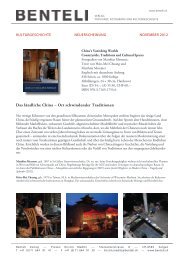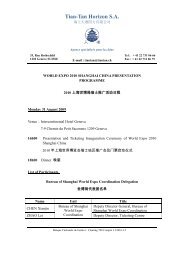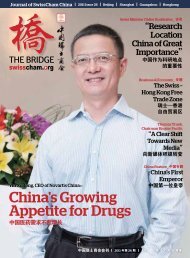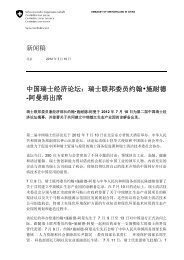Research and Environment News from China - Number 29 - SinOptic
Research and Environment News from China - Number 29 - SinOptic
Research and Environment News from China - Number 29 - SinOptic
You also want an ePaper? Increase the reach of your titles
YUMPU automatically turns print PDFs into web optimized ePapers that Google loves.
Schweizerische Eidgenossenschaft<br />
Confédération suisse<br />
Confederazione Svizzera<br />
Confederaziun Svizra<br />
Federal Department of Foreign Affairs<br />
Embassy of Switzerl<strong>and</strong> in <strong>China</strong><br />
<strong>Environment</strong>, Science, Technology, Health section<br />
<strong>Research</strong> <strong>and</strong> <strong>Environment</strong> <strong>News</strong> <strong>from</strong> <strong>China</strong><br />
<strong>Number</strong> <strong>29</strong> – November 2006<br />
Please note that the previous newsletters can be downloaded <strong>from</strong> the Website of the Embassy of Switzerl<strong>and</strong> in<br />
<strong>China</strong>: www.eda.admin.ch/beijing. To subscribe/ unsubscribe or send us your comments, please send an eMail with<br />
the corresponding subject to hang.gao@eda.admin.ch.<br />
Innt I trroodduucct ti iioonn<br />
<strong>China</strong> issued yesterday a five-year program (2006-2010) on international cooperation in science <strong>and</strong> technology,<br />
<strong>and</strong> promised that key national scientific <strong>and</strong> technological projects <strong>and</strong> funds would be open to overseas partners.<br />
Pollution continues to grow in <strong>China</strong>, <strong>and</strong> the SEPA (State <strong>Environment</strong>al Protection Agency) admits in a report that<br />
the objectives are not being reached, e.g. about water pollution. A major index of water pollution (chemical oxygen<br />
dem<strong>and</strong>) continues to increase in the food-processing, paper-making <strong>and</strong> chemical industry.<br />
A workshop of Legislation on E-waste Recycling, organised by the <strong>Environment</strong>al Protection & Resources<br />
Conservation Committee, National People's Congress, P. R. <strong>China</strong> with EMPA's support (Swiss Federal Laboratories<br />
for Materials Testing <strong>and</strong> <strong>Research</strong>), will be held in Beijing on Dec. 12, 2006, within the "Knowledge Partnership in Ewaste<br />
Recycling in India, South Africa <strong>and</strong> <strong>China</strong>" programme, financed by State Secretariat for Economic Affairs<br />
(SECO). Participants will include officials <strong>from</strong> Swiss <strong>and</strong> Chinese authorities <strong>and</strong> institutions/universities experts <strong>from</strong><br />
both sides, who will discuss the current status/problems of legislation of E-waste recycling in <strong>China</strong>.<br />
Scci iieennccee & Teecchhnnool llooggyy<br />
KEYWORDS<br />
1. <strong>China</strong> successfully launches new-generation satellite satellite launches<br />
2. <strong>China</strong> catching up in basic science research <strong>China</strong>’s science research<br />
3. <strong>China</strong> starts to build own satellite navigation system satellite navigation system<br />
4. <strong>China</strong> to launch 2 satellites for Compass navigation system satellite launches<br />
5. <strong>China</strong> Plans to Open Wider in Science, Technology <strong>China</strong> S&T<br />
Enneerrggyy KEYWORDS<br />
1. Interview: <strong>China</strong> to develop renewable energy renewable energy<br />
2. World's largest solar power station to be built in NW. <strong>China</strong> city solar power station<br />
Ennvvi iirroonnmeennt t<br />
KEYWORDS<br />
1. <strong>China</strong> to contribute to world's sustainable development: vice premier sustainable development<br />
2. Pollution on the rise as economy surges pollution<br />
3. HK losing expats to S'pore as smog turns many away air pollution<br />
4. Novartis sets up research centre in Shanghai Novartis research centre
Schweizerische Eidgenossenschaft<br />
Confédération suisse<br />
Confederazione Svizzera<br />
Confederaziun Svizra<br />
Federal Department of Foreign Affairs<br />
Embassy of Switzerl<strong>and</strong> in <strong>China</strong><br />
<strong>Environment</strong>, Science, Technology, Health section<br />
5. <strong>China</strong>'s first hydrogen refueling station goes into operation hydrogen refueling station<br />
6. Pollution Increases in First Half of 2006 Pollution<br />
Heeaal llt thh<br />
1. HIV/AIDS cases in <strong>China</strong> up by 30% AIDS<br />
22. ..<br />
KEYWORDS<br />
Wild fruit poisons 43 children in S. <strong>China</strong> county fruit poison<br />
Acct ti iivvi iit teess<br />
ccoomi iinngg uupp ssoooonn<br />
December 12 – 16, 2006<br />
The Eleventh Asian Technology Conference in Mathematics<br />
Hong Kong Polytechnic University, Hong Kong, Hong Kong<br />
January 15-16, 2007<br />
The 4th International Workshop on Energy <strong>and</strong> <strong>Environment</strong> of Residential Buildings (IWEERB 2007)<br />
Venue: Harbin Institute of Technology<br />
Contact: Mr.Zhi Weiluo<br />
Tel: 86-0451-898 60889 Fax: 86-0451-8628 2123<br />
E-mail: iweerb2007@hit.edu.cn<br />
April 23 – 25, 2007<br />
The 7th International Exhibition on Nuclear Power Industry<br />
Shanghai, <strong>China</strong><br />
April 27 – <strong>29</strong>, 2007<br />
The 8 th <strong>China</strong> International <strong>Environment</strong>al Protection Exhibition<br />
Shanghai, <strong>China</strong><br />
May 20-23, 2007<br />
The 14 th International Conference on Interdisciplinary Mathematical & Statisticla Techniques<br />
Shanghai, <strong>China</strong><br />
June 5 – 7, 2007<br />
The 11th International Electric Power Industry, Power Network Technology & Power Supply<br />
Equipment Expo<br />
Guangzhou, <strong>China</strong><br />
June 5 – 7, 2007<br />
The 3rd International Renewable Energy & Energy <strong>Environment</strong>al Protection Technology Expo\<br />
Guangzhou, <strong>China</strong><br />
Ennvvi iirroonnmeennt t--rreel llaat teedd iinnt i teerrnnaat ti iioonnaal ll teennddeerrss t<br />
english.cepi.com.cn/homepage/homepage.jsp<br />
aanndd iinnvveesst i tmeennt t ooppppoorrt tuunni iit ti iieess: :
Schweizerische Eidgenossenschaft<br />
Confédération suisse<br />
Confederazione Svizzera<br />
Confederaziun Svizra<br />
Coonnt taacct t<br />
Federal Department of Foreign Affairs<br />
Embassy of Switzerl<strong>and</strong> in <strong>China</strong><br />
<strong>Environment</strong>, Science, Technology, Health section<br />
Patrick Freymond<br />
Counsellor, Head of Science, Technology, <strong>Environment</strong>, Health, Project Financing<br />
Embassy of Switzerl<strong>and</strong> in the People’s Republic of <strong>China</strong><br />
Tel +86 10 6532 2736 ext 311<br />
eMail: patrick.freymond@eda.admin.ch<br />
www.eda.admin.ch/beijing<br />
Science & Technology<br />
<strong>China</strong> successfully launches new-generation satellite<br />
(<strong>China</strong> Daily, 2006-10-30)<br />
XICHANG, Sichuan Province: <strong>China</strong> successfully launched a domestically manufactured high-power<br />
communications <strong>and</strong> broadcast satellite aboard a Long March-3B carrier rocket yesterday.<br />
The new-generation SinoSat-2 satellite, launched <strong>from</strong> the Xichang Satellite Launch Centre in Southwest <strong>China</strong>'s<br />
Sichuan Province, is designed to provide broadcast TV, digital TV, live broadcast TV <strong>and</strong> digital broadb<strong>and</strong><br />
multimedia services to the Chinese mainl<strong>and</strong>, Hong Kong, Macao <strong>and</strong> Taiwan.<br />
The satellite split off <strong>from</strong> the rocket about 25 minutes after its 00:20 lift-off, entering a geosynchronous transfer orbit.<br />
Its orbit will be adjusted several times by comm<strong>and</strong>ers on the ground until it is positioned above the equator at 92.2<br />
East Longitude.<br />
SinoSat-2, mainly developed <strong>and</strong> manufactured by the Chinese Academy of Space Technology, weighs about 5.1<br />
tons <strong>and</strong> has 22 transponders. It is designed to last for 15 years, spending 12 years in orbit.<br />
The carrier rocket used in the launch was developed <strong>and</strong> manufactured by the Chinese Academy of Launch Vehicle<br />
Technology. The launch marked the 93rd flight for the Long March series of carrier rockets <strong>and</strong> <strong>China</strong>'s 51st<br />
consecutive successful space launch since October 1996.<br />
A SINO Satellite Communications Co Ltd (SINOSAT) official said SinoSat-2 will improve the capacity, safety <strong>and</strong><br />
reliability of <strong>China</strong>'s information broadcasts <strong>and</strong> make it easier to carry out live TV broadcasts.<br />
The original SinoSat-1 satellite, launched in July 1998, was designed to boost <strong>China</strong>'s radio <strong>and</strong> TV broadcasts <strong>and</strong><br />
communications services in the Asia-Pacific Region.<br />
SinoSat-3, intended specifically for radio <strong>and</strong> TV services, is currently being developed. It will go into operation in<br />
2007, according to the official.<br />
<strong>China</strong> catching up in basic science research<br />
(Xinhua, 2006-11-16)<br />
BEIJING -- <strong>China</strong> is catching up with the forerunners in basic science research, with an increasing number of<br />
themes <strong>and</strong> journals complied by Chinese scientists being referenced by the Science Citation Index (SCI), according<br />
to <strong>China</strong>'s Ministry of Science <strong>and</strong> Technology (MOST).<br />
<strong>China</strong> was ranked fifth in the world in terms of the number of its journals cited by the SCI in 2004 <strong>and</strong> 2005, up <strong>from</strong><br />
15th place in 1991, MOST statistics showed. "The number of our themes <strong>and</strong> journals cited by the SCI is an<br />
important indicator of the success of our research progress in basic science fields," said Zhang Xianen, the director<br />
of MOST's scientific research department.
Schweizerische Eidgenossenschaft<br />
Confédération suisse<br />
Confederazione Svizzera<br />
Confederaziun Svizra<br />
Federal Department of Foreign Affairs<br />
Embassy of Switzerl<strong>and</strong> in <strong>China</strong><br />
<strong>Environment</strong>, Science, Technology, Health section<br />
"The greater number of Chinese scientists winning international prizes <strong>and</strong> occupying senior positions in major<br />
international research organizations also proves that <strong>China</strong> is catching up with leading countries in the field of<br />
science <strong>and</strong> technology," Zhang said. In the last two years, 14 Chinese scientists have won international prizes<br />
including the Fresnel Prize awarded by the European Physical Society, <strong>and</strong> 40 Chinese have been granted<br />
memberships to international academic organizations <strong>and</strong> science academies of other countries, he said.<br />
MOST statistics show that there were 115,400 basic science researchers in <strong>China</strong> in 2005, 46.5 percent higher than<br />
in 2001. The Chinese government has promised to increase the country's investment in basic science research in an<br />
attempt to build a "self-innovative" country.<br />
<strong>China</strong> starts to build own satellite navigation system<br />
http://english.people.com.cn/200611/02/eng20061102_317576.html<br />
<strong>China</strong> to launch 2 satellites for Compass navigation system<br />
http://english.people.com.cn/200611/14/eng20061114_321287.html<br />
<strong>China</strong> Plans to Open Wider in Science, Technology<br />
http://www.china.org.cn/english/news/1910<strong>29</strong>.htm<br />
Energy<br />
Interview: <strong>China</strong> to develop renewable energy<br />
(Xinhua, 2006-11-02)<br />
(<strong>China</strong> Daily, 2006-11-14)<br />
(Xinhua <strong>News</strong> Agency, 2006-12-04)<br />
(People's Daily Online, 2006-11-02)<br />
Given that <strong>China</strong>'s manufacturing technology is not advanced enough to build crucial industrial equipment, the<br />
Chinese government should formulate a favorable policy <strong>and</strong> give more financial support to the development of<br />
renewable energy, said Su Ming, deputy director of the <strong>Research</strong> Institute for Fiscal Science under <strong>China</strong>'s<br />
Ministry of Finance in a recent interview.<br />
Su stressed three points in the interview: that <strong>China</strong> should increase financial support to develop renewable energy;<br />
that backward manufacturing technology has hindered the development of crucial industrial equipment <strong>and</strong> that the<br />
government should formulate favorable policies to expedite technological updates; <strong>and</strong> that fossil fuel consumption<br />
is depleting resources.<br />
Q: Recently, the Ministry of Finance promulgated "Interim measures for the administration of special funds for the<br />
development of renewable energy". Could you please explain the background <strong>and</strong> significance of these measures?<br />
Su Ming: By publicizing the financial management structure of these special funds, the Ministry of Finance is<br />
sending a strong signal to the world, easing people's concerns about the energy sector <strong>and</strong> economic sector as a<br />
whole. In its rapidly developing economy, <strong>China</strong> attaches great importance to energy restructuring <strong>and</strong> security <strong>and</strong><br />
is determined to make progress in renewable energy development.<br />
For a long time, <strong>China</strong>'s energy supply was based on non-renewable fossil fuels, which have inevitably depleted<br />
over time. Clearly this is not a sustainable practice. On the contrary, the development <strong>and</strong> use of renewable energy<br />
can be endless, <strong>and</strong> in the process creates little or no environmental pollution. There is no doubt that renewable<br />
energy will be essential in the future; <strong>China</strong> needs effective energy strategies for sustainable development. Many<br />
countries have introduced a policy promoting the development <strong>and</strong> use of renewable energy. <strong>China</strong> is one of them.<br />
The new interim measures for the administration of special fund for the development of renewable energy define the<br />
scope <strong>and</strong> principles of the policy as well as focus on specific steps the government is taking to finance renewable<br />
energy development. This will be conducive to increasing government investment in renewable energy, better<br />
introducing social investment <strong>and</strong> bank funds into the sector, <strong>and</strong> promoting the development of renewable energy.
Schweizerische Eidgenossenschaft<br />
Confédération suisse<br />
Confederazione Svizzera<br />
Confederaziun Svizra<br />
Big gap between <strong>China</strong> <strong>and</strong> other countries<br />
Federal Department of Foreign Affairs<br />
Embassy of Switzerl<strong>and</strong> in <strong>China</strong><br />
<strong>Environment</strong>, Science, Technology, Health section<br />
Q: Would you please briefly outline the development of renewable energy both in <strong>and</strong> outside <strong>China</strong>?<br />
Su Ming: For the past 20 years, many countries have supported renewable energy development. With relevant<br />
technologies developing rapidly, renewable energy has become an important part of the energy system. The<br />
capacity of wind power generators across the world increased <strong>from</strong> 1930 megawatts in 1990 to 39,390 megawatts in<br />
2004. The output of solar energy batteries also surged <strong>from</strong> 47 megawatts to 1190 megawatts. <strong>China</strong> is still in the<br />
early stage of the overall development of renewable energy. There is a big gap between <strong>China</strong> <strong>and</strong> developed<br />
countries. Despite some substantial progress having been made <strong>and</strong> the emergence of a number of commercial<br />
technologies, <strong>China</strong> is still in the research <strong>and</strong> demonstration phase with most technology needed in renewable<br />
energy projects. Its industrial scale is small <strong>and</strong> market capacity low. In 2004 the volume of energy supplied by<br />
<strong>China</strong>'s new renewable energy equals to the energy capacity of 60 million tons of st<strong>and</strong>ard coal, an increase of 43<br />
million tons <strong>from</strong> 1990. However, if compared to its overall energy system, the size is still quite small, accounting for<br />
only 2.6% of the country's total energy consumption in 2004. Generally speaking, there is still a big gap between<br />
<strong>China</strong>'s renewable energy development <strong>and</strong> that of foreign countries.<br />
Financial <strong>and</strong> taxation policies of great importance<br />
Q: What are the functions of the government <strong>and</strong> its fiscal policies in promoting the development of renewable<br />
energy?<br />
Su Ming: Based on the economic, social, energy, <strong>and</strong> environment policy objectives for development, the<br />
government shoulders an important responsibility in supporting <strong>and</strong> promoting the industrial development of<br />
renewable energy. In different stages of renewable energy development, we need different policies <strong>and</strong><br />
management concepts. In the initial stage, the government needs to support the development <strong>and</strong> demonstration of<br />
renewable energy <strong>and</strong> offer subsidies <strong>and</strong> tax incentives. The government should take the lead on this initiative.<br />
Once the industry has exp<strong>and</strong>ed <strong>and</strong> commercialized, it will not need to rely on government support. It will be a<br />
st<strong>and</strong>ardized, stable, constantly exp<strong>and</strong>ing market. The government should then reduce economic incentives <strong>and</strong><br />
replace them with regulatory policies. Eventually government policy will be integrated with the market economy<br />
system.<br />
There are multiple reasons for the under-development of clean energy <strong>and</strong> renewable energy resources in <strong>China</strong>.<br />
The current situation is closely tied to incomplete government functions, ineffective macroeconomic policies, <strong>and</strong> an<br />
imperfect <strong>and</strong> inadequate fiscal policy support system. The government should emphasize the development of<br />
renewable energy in its fiscal policies, both now <strong>and</strong> in the long term. Taxation policies, investment policies,<br />
subsidies <strong>and</strong> discounts should all be employed to strengthen policies favoring the development of renewable<br />
energy.<br />
<strong>China</strong>'s renewable energy industry small <strong>and</strong> weak<br />
Q: The interim measures outlined by the Ministry of Finance clearly define the scale, focus <strong>and</strong> means of support for<br />
renewable energy development. What do you think of these strategies?<br />
Su Ming: <strong>China</strong>'s renewable energy industry is still in its infancy; it is small <strong>and</strong> weak <strong>and</strong> needs financial <strong>and</strong> policy<br />
support <strong>from</strong> the government. At present, the main obstacle to renewable energy in <strong>China</strong> is backward technology.<br />
We have to rely on imported equipment. Furthermore, given the high cost of investment, power generation <strong>and</strong><br />
pricing, renewable energy cannot compete with conventional energy resources <strong>and</strong> there is difficulty exp<strong>and</strong>ing the<br />
market. The fact that we do not expect it to become an effective complement to conventional energy in the shortterm<br />
further weakens the possibility of renewable energy becoming the basis of the energy industry in the future. As<br />
a result, we might lose a good chance to secure cutting edge energy technology <strong>and</strong> get a share in the international<br />
market. Consequently, there is a big need to get more financial support <strong>from</strong> the government for renewable energy<br />
development. This is closely related to important strategic issues in <strong>China</strong> such as overall energy security, energy<br />
restructuring <strong>and</strong> optimizing, <strong>and</strong> the improvement of the environment.<br />
It is important too to bear in mind that our financial resources are limited within a certain period of time. The<br />
government should have a clear direction <strong>and</strong> focus, so that financial policies can play a leading role.<br />
It is in precisely this situation that the Chinese government has defined the goals of this special fund <strong>and</strong> financial<br />
management policy: scientific <strong>and</strong> technological research <strong>and</strong> development; use of renewable energy resources in<br />
remote agricultural <strong>and</strong> livestock areas; exploration of resources; equipment manufacturing <strong>and</strong> more. Support will<br />
be given to key projects involving the development of alternatives to oil, such as solar energy, geothermal energy,
Schweizerische Eidgenossenschaft<br />
Confédération suisse<br />
Confederazione Svizzera<br />
Confederaziun Svizra<br />
Federal Department of Foreign Affairs<br />
Embassy of Switzerl<strong>and</strong> in <strong>China</strong><br />
<strong>Environment</strong>, Science, Technology, Health section<br />
wind energy <strong>and</strong> ocean energy. The interim measures target the development of renewable energy in <strong>China</strong> <strong>and</strong><br />
take into account several important factors in the development of renewable energy, which will eventually promote<br />
healthy <strong>and</strong> effective development.<br />
It is worth noting that this approach proposes two methods of support: gratis financial support <strong>and</strong> discount loans.<br />
Gratis financial support means that funding will come <strong>from</strong> a range of sources including the government, businesses<br />
<strong>and</strong> even individuals. A discount loan is really another kind of government investment; it makes better use of bank<br />
loans, exp<strong>and</strong>s the overall scale of investment <strong>and</strong> lowers investment costs. Discount loans are applicable in a<br />
broader scope <strong>and</strong> its function should not be underestimated.<br />
World's largest solar power station to be built in NW. <strong>China</strong> city<br />
http://english.people.com.cn/200611/21/eng20061121_323677.html<br />
<strong>Environment</strong><br />
<strong>China</strong> to contribute to world's sustainable development: vice premier<br />
(Xinhua, 2006-11-21)<br />
(Xinhua, 2006-11-11)<br />
<strong>China</strong> will try to resolve its current outst<strong>and</strong>ing environmental problems <strong>and</strong> realize its environmental goals as set<br />
out in the 11th Five-Year Plan period (2006-2010), says Vice-Premier Zeng Peiyan. Zeng told the <strong>China</strong> Council for<br />
International Cooperation on <strong>Environment</strong> <strong>and</strong> Development (CCICED) that <strong>China</strong> also hopes to contribute to the<br />
world's sustainable development.<br />
By 2010, <strong>China</strong> plans to improve the environment in major areas <strong>and</strong> cities. Initially it will attempt to curb the<br />
deterioration of the environment by reducing the amount of energy required to produce a unit GDP by 20 percent<br />
<strong>and</strong> total discharge of CO2 by 10 percent. It will maintain 120 million hectares of cultivated l<strong>and</strong>; <strong>and</strong> increase forest<br />
coverage to 20 percent, up <strong>from</strong> the current 18.2 percent, said Zeng. Since its founding 15 years ago the CCICED,<br />
has contributed to <strong>China</strong>'s undertakings on sustainable development, said Zeng. He urged the organization to study<br />
environmental problems <strong>and</strong> give more <strong>and</strong> better proposals on the issue.<br />
The meeting was chaired by Zhou Shengxian, minister of the State <strong>Environment</strong>al Protection Administration, <strong>and</strong><br />
attended by officials <strong>and</strong> representatives <strong>from</strong> Chinese <strong>and</strong> foreign governments, the United Nations <strong>and</strong> other<br />
international bodies, <strong>and</strong> some domestic <strong>and</strong> international observers <strong>and</strong> scholars. Cheng Siwei, vice chairman of<br />
the St<strong>and</strong>ing Committee of the National People's Congress (NPC) was also in attendance. The CCICED was<br />
established in 1992, by the Chinese government, foreign governments, <strong>and</strong> international organizations.<br />
Pollution on the rise as economy surges<br />
(<strong>China</strong> Daily, 2006-11-22)<br />
BEIJING - The amount of pollution discharged into <strong>China</strong>'s rivers <strong>and</strong> lakes has increased this year despite<br />
government efforts to improve factories' environmental practices.
Schweizerische Eidgenossenschaft<br />
Confédération suisse<br />
Confederazione Svizzera<br />
Confederaziun Svizra<br />
Sunset of a Beijing highway. The<br />
amount of pollution discharged into<br />
<strong>China</strong>'s rivers <strong>and</strong> lakes has increased<br />
this year despite government efforts to<br />
improve factories' environmental<br />
practices. [AFP]<br />
Federal Department of Foreign Affairs<br />
Embassy of Switzerl<strong>and</strong> in <strong>China</strong><br />
<strong>Environment</strong>, Science, Technology, Health section<br />
<strong>China</strong> produced more than 12 billion tons of industrial waste-water in the<br />
first half of 2006, up 2.4 percent <strong>from</strong> the same period last year, a State<br />
<strong>Environment</strong> Protection Administration report said. A major index of water<br />
pollution called the chemical oxygen dem<strong>and</strong> increased by 3.7 percent in<br />
the first six months, while emissions of sulphur dioxide rose 4.2 percent, the<br />
report said. Acid rain, which affects almost one-third of the nation, also<br />
remained unchecked, it said.<br />
The environment watchdog attributed the increased volume of pollution to<br />
the country's booming industries, as the economy steamed ahead by 10.9<br />
percent in the first half of the year. It said food-processing, paper-making<br />
<strong>and</strong> chemical plants accounted for more than 80 percent of the increase in<br />
the chemical oxygen dem<strong>and</strong> level.<br />
The watchdog said only 30 to 40 percent of public industrial projects had<br />
undergone environmental evaluations before they went ahead, <strong>and</strong><br />
criticized local governments for not implementing strict environment<br />
protection policies.<br />
"The quality of the country's overall environment remained unchanged or<br />
deteriorated in some areas," said the report.<br />
The country has already failed to meet some of the key environmental<br />
objectives in its latest five-year national economic <strong>and</strong> social plan, it said. In September, the state environment<br />
watchdog said pollution had inflicted economic losses of 511.8 billion yuan (65.8 billion dollars) on the country in<br />
2004, or three percent of <strong>China</strong>'s GDP that year.<br />
HK losing expats to S'pore as smog turns many away<br />
(Business Times, 2006-11-26)<br />
HONG KONG's worsening air pollution <strong>and</strong> sparse international school space is prompting more <strong>and</strong> more<br />
executives to relocate to Singapore.<br />
Headhunters <strong>and</strong> recruitment agencies are finding it increasingly difficult to attract c<strong>and</strong>idates to the smog-heavy city,<br />
as concerns over respiratory illnesses <strong>and</strong> general quality-of-life issues kick in.<br />
The Hong Kong government is being criticised over its record on environmental issues, with green groups <strong>and</strong><br />
business chambers increasingly claiming that its anti-pollution measures have been ineffective. Recruiters are<br />
finding that c<strong>and</strong>idates are either backtracking on appointments at the last moment in preference for Singapore or<br />
are simply relocating their families there as a result of worries about the environment in Hong Kong.<br />
'It's a real problem that's not being addressed by the government,' says Philip Eisenbeiss, a headhunter at Executive<br />
Access.'We're getting a significant number of c<strong>and</strong>idates <strong>from</strong> overseas - they are getting top offers here, <strong>and</strong> come<br />
over <strong>and</strong> the spouse kills the deal. The pollution is a huge issue,' he explains.<br />
Singapore is an obvious alternative because of its location in the region, international schools <strong>and</strong> lower rents.This<br />
despite the fact that for a couple of months each year the republic, along with other countries in the region, is<br />
subjected to a haze resulting <strong>from</strong> forest fires in neighbouring Indonesia.
Schweizerische Eidgenossenschaft<br />
Confédération suisse<br />
Confederazione Svizzera<br />
Confederaziun Svizra<br />
Federal Department of Foreign Affairs<br />
Embassy of Switzerl<strong>and</strong> in <strong>China</strong><br />
<strong>Environment</strong>, Science, Technology, Health section<br />
'I'm losing people in my own office - people can't take it any more, their kids are sick all the time,' Mr Eisenbeiss says.<br />
Brenda Wilson, a senior director with Mercer Human Resource Consulting in Hong Kong, agrees, saying: 'Many of<br />
them (executives) are selecting Singapore. When they have a choice <strong>and</strong> after speaking to a variety of people,<br />
Singapore is an attractive choice.'<br />
Green groups have also noticed a migration. 'We do hear that (executives moving to Singapore),' says Annelise<br />
Connell, vice-chair of the group called Clear the Air. 'We know people who have gone.'In one of the most damning<br />
indictments of Hong Kong's worsening pollution, one of the city's top marathon runners, Mark Williams, uprooted his<br />
family in July <strong>and</strong> moved to New Zeal<strong>and</strong>, saying the move was prompted by concerns about air quality.<br />
The departure of Mr Williams came just months after the annual St<strong>and</strong>ard Chartered marathon turned into a public<br />
relations disaster for the government, with two people dying <strong>and</strong> scores becoming ill after pollution levels hit nearly<br />
150. Quality of life surveys are also becoming an embarrassment for the government, with the city slipping quite<br />
dramatically in rankings such as the ECA International survey this year. The human resources consultancy found<br />
that Hong Kong had slumped to 32nd place as the best of 257 locations to live in worldwide in 2006, compared to<br />
20th in 2005.<br />
As Michael Raytek of recruiter Hunt Partners explains, pollution is increasingly becoming part of a family's decisionmaking<br />
process when it comes to job offers. 'These are people who travel to Hong Kong <strong>and</strong> know about it (the<br />
pollution), but haven't lived here,' he stresses.<br />
He cites a recent case where two job offers fell through because the firm could not entice c<strong>and</strong>idates away <strong>from</strong><br />
Singapore to Hong Kong. 'We have personally felt the difficulties in terms of moving expatriates out of Singapore<br />
into Hong Kong,' he says. 'That is something that's coming up more <strong>and</strong> more often. The perception of pollution<br />
plays a role.'<br />
One of the c<strong>and</strong>idates had two children, <strong>and</strong> the other had three. School places are tight in Hong Kong for<br />
international students, but Mr Raytek says: 'We never even got to that point, though it would have been the next<br />
hurdle.' Much of Hong Kong's pollution comes <strong>from</strong> the neighbouring province of Guangdong <strong>and</strong> the industrial<br />
hinterl<strong>and</strong> of the Pearl River Delta. However, up to 40 per cent of the city's street level pollution is attributed to<br />
vehicle emissions <strong>and</strong> power companies' environmental shortcomings.<br />
Novartis sets up research centre in Shanghai<br />
(Swiss info, 2006-11-06)<br />
http://www.swissinfo.org/eng/business/detail/Novartis_sets_up_research_centre_in_Shanghai.html?siteSect=161&si<br />
d=7228688<br />
<strong>China</strong>'s first hydrogen refueling station goes into operation<br />
http://english.people.com.cn/200611/09/eng20061109_319882.html<br />
Pollution Increases in First Half of 2006<br />
http://www.china.org.cn/english/environment/189792.htm<br />
Health<br />
HIV/AIDS cases in <strong>China</strong> up by 30%<br />
(Xinhua, 2006-11-09)<br />
(<strong>China</strong> Daily, 2006-11-22)<br />
(People Daily, 2006-11-22)<br />
The reported number of HIV/AIDS cases in <strong>China</strong> has grown by nearly 30 per cent this year compared with last year,<br />
according to figures released yesterday by the Ministry of Health. Health officials attributed many of the new cases<br />
to better reporting of existing cases, though they also warned that the virus seemed to be spreading <strong>from</strong> high-risk<br />
groups to the general public.
Schweizerische Eidgenossenschaft<br />
Confédération suisse<br />
Confederazione Svizzera<br />
Confederaziun Svizra<br />
Federal Department of Foreign Affairs<br />
Embassy of Switzerl<strong>and</strong> in <strong>China</strong><br />
<strong>Environment</strong>, Science, Technology, Health section<br />
The reported number of cases has grown to 183,733 this year, up <strong>from</strong> 144,089 at the end of last year, according to<br />
statistics announced by the Ministry of Health yesterday. Of the reported cases, 40,667 have developed into AIDS,<br />
statistics showed. Experts <strong>from</strong> the United Nations <strong>and</strong> the Ministry of Health estimate that some 650,000 people in<br />
<strong>China</strong> carried HIV at the end of December 2005, suggesting that many people were unaware that they carry the<br />
virus.<br />
As of October 31, 12,464 people have died in <strong>China</strong> as a result of illnesses associated with the HIV virus, Hao Yang,<br />
deputy director of the Ministry of Health's Disease Control Bureau, said yesterday. Hao added that virus appeared to<br />
be spreading <strong>from</strong> so-called high-risk groups to the general public.<br />
Drug abuse accounted for 37 per cent of the cases reported in the first 10 months of the year, while unsafe sexual<br />
contact had caused 28 per cent, Hao noted, adding that these two activities had caused most of the infections.<br />
Before 2002, only 10 per cent of all infections were caused by sexual contact. Ministry officials who have been<br />
observing monitoring sites around the country have found that the percentage of sex workers infected by HIV/AIDS<br />
had grown to 1 per cent last year, compared with only 0.02 per cent in 1996.<br />
HIV testing has found that the infection rate among pregnant women in provinces that are experiencing serious<br />
epidemics, such as Southwest <strong>China</strong>'s Yunnan Province, is about 1 per cent. Such statistics are the clearest<br />
evidence that the virus is spreading <strong>from</strong> high-risk groups to the general public as a result of unsafe sexual contact<br />
<strong>and</strong> drug abuse.<br />
Hao said these two causes posed a great danger because effective measures to dissuade unsafe behaviour are not<br />
yet in place. For example, according to an investigation by public health workers, only 38 per cent of prostitutes in<br />
certain areas insisted on using condoms during intercourse. And about half of the drug abusers surveyed still share<br />
syringes while taking intravenous drugs, Hao said.<br />
Sexual activity among gay men is also an important source of new HIV/AIDS infections. Statistics show that in some<br />
areas the infection rate among gay men is between 1 <strong>and</strong> 4 per cent. Government officials have launched a<br />
concerted effort to prevent <strong>and</strong> control HIV/AIDS in recent years. It has greatly enhanced HIV testing <strong>and</strong> monitoring<br />
among both high-risk groups <strong>and</strong> the general public, which has helped public health workers identify more cases.<br />
For example, the provincial government of Central <strong>China</strong>'s Henan launched a wide-ranging investigation of people<br />
who sold blood in 1990s <strong>and</strong> found more than 30,000 carriers, the majority of which had been infected by<br />
contaminated blood. Farmers <strong>from</strong> many regions, especailly in Henan, Shanxi <strong>and</strong> Anhui, sold blood in the 1990s to<br />
earn extra money. Among the total reported cases this year, 5.1 per cent were caused by people selling blood<br />
illegally or receiving infected blood <strong>from</strong> hospitals.<br />
The central government also offers free HIV testing, free anti-virus treatment <strong>and</strong> free education for the children of<br />
people with HIV/AIDS. Some 28,757 people in 31 provinces <strong>and</strong> regions received free anti-viral treatment. By the<br />
end of this year, the number will reach to 30,000.<br />
Wild fruit poisons 43 children in S. <strong>China</strong> county<br />
http://www.chinadaily.com.cn/china/2006-11/21/content_739257.htm<br />
(Xinhua, 2006-11-21)
















